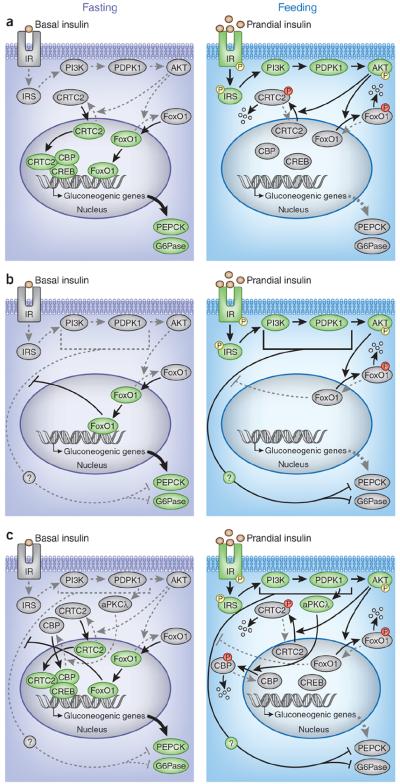Figure 1.
Insulin signaling pathways that control gluconeogenesis. (a) The canonical insulin receptor (IR)-IRS-PI3K-PDPK1-AKT signaling pathway regulates gluconeogenesis by inhibiting the transcription factor FoxO1 and the transcriptional regulatory CREB-CBP-CRTC2 complex. After feeding, insulin receptor–IRS-PI3K-PDPK1-AKT signaling is stimulated (green), which phosphorylates and inactivates FoxO1 and the CREB-CBP-CRTC2 complex, thus suppressing the expression of gluconeogenic genes (encoding PEPCK and G6Pase) (gray). During fasting, insulin receptor–IRS-PI3K-PDPK1-AKT signaling is less active than in feeding (gray), thus turning on the activities of FoxO1, the CREB-CBP-CRTC2 complex and gluconeogenesis (green). The P in the yellow circles denotes activating phosphorylation, and the P in the red circles denotes inhibitory phosphorylation. (b) Lu et al.8 suggest the existence of a hypothetical non-canonical pathway by which insulin controls gluconeogenesis. They suggest that the non-canonical pathway, which has yet to be identified, suppresses gluconeogenesis in parallel with the canonical pathway during feeding; however, activated FoxO1 during fasting or insulin resistance dampens the non-canonical pathway and stimulates the expression of gluconeogenic genes and glucose production. A comparison of TLKO mice and LTKOIRS mice implied that the divergent point of the non-canonical pathway from the canonical pathway could reside between IRS and AKT. (c) The PDPK1-aPKCl signaling cascade may be a potential candidate accounting for the non-canonical pathway. In response to insulin or stimuli after feeding, insulin receptor–IRS-PI3K-PDPK1 signaling activates aPKCλ, which, in turn, phosphorylates CBP and disrupts the CREB-CBP-CRTC2 complex and suppresses gluconeogenesis. However, in DLKO or TLKO mice, this pathway could remain active and contribute to the postprandial response.

